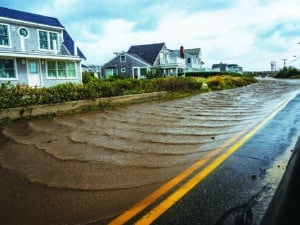
Houses in Falmouth look out on a road being flooded by a “bomb cyclone” storm in 2019. Seaside homes face increasing risks from storm surges and sea level rise as climate change continues.
New research suggests Massachusetts homes face substantially higher costs from flooding over the next 30 years as climate change worsens the risk of strong storms.
The nonprofit First Street Foundation says that nearly 31,000 homes outside of federally defined flood-prone zones statewide would have to pay an average of $4,043 per year in federal flood insurance premiums if those premiums reflected actual risk. First Street estimates properties would only pay an average of $485 per year under the National Flood Insurance Program’s current structure.
Homeowners across the country face challenges over the next 30 years, said Matthew Eby, First Street’s executive director.
First, the National Flood Insurance Program (NFIP), administered by the Federal Emergency Management Agency (FEMA), is expected to shift to a new rate structure this fall that reflects actual risk for properties in current flood zones. These properties are required by law to buy flood insurance intended to cover repair costs, and FEMA has embarked on a process called “Risk Rating 2.0” that will likely increase many homeowners’ premiums substantially over the next few years.
“What does that do to home values? Adding cost of ownership, carrying costs, it’s going to bring the cost of a home down if you have a $600,000 home and you’re being told you have to start paying $5,200 a year,” Eby said.
Insurance Premiums to Rise
First Street estimates the average NFIP premium for a one- to four-family home inside Massachusetts’s designated flood zones is $1,702. If current, known risks were included, the foundation estimates that figure should be $7,011, based on factors like the expected height of floodwaters under different scenarios and property characteristics like the height of a home’s first finished floor.
“There are people whose prices should go down and there’s prices that should go really high up. That’s where our model comes in,” Eby said.
Increases in FEMA flood zone premiums may not have a substantial impact on prices of high-end residential properties, Massachusetts Association of Realtors Executive Director Theresa Hatton said, as most of those owners self-insure thanks to the $250,000 cap on federal flood insurance payouts. And while NFIP premiums will go up for many properties at risk of flooding, older properties that have weathered years of storms without damage will see a premium reduction, she said, making the question of pricing impacts difficult to answer.
“It’s going to be specific to each property,” she said. “If you’ve got an older home and let’s say it was built on the highest part of the property – I’m looking out my window and I see [the ground] trailing down and there’s a swamp over there – some of these properties will be fine.”
Flooding Could Get Worse
But the FEMA flood zones currently do not take changes likely to be cause by climate change over the next 30 years, like sea level rise or more frequent severe storms, into account, Eby said. This, said Conservation Law Foundation Director of Environmental Planning Deanna Moran, masks the full extent of risk to homebuyers.
The state has 30,848 one- to four-family homes outside FEMA flood zones at “substantial” risk of flood damage, compared to only 13,420 within the flood zones, First Street estimates, which face possible flood damages over the next 30 years totaling $7.7 billion. Much of the potential increase in damage is concentrated in Boston, Nantucket, the South Shore and Cape Cod.
“We know this is an issue. After Hurricane Harvey [hit Texas in 2017], the total residential damage was $2.3 billion and a lot of those damages weren’t insured because they weren’t located in a floodplain,” Moran said in an interview.
And increased flooding brought by climate change could pose a greater financial risk to less well-off residents in many Massachusetts cities – particularly in neighborhoods dominated by people of color that were once redlined.
“There is a huge correlation between environmental justice communities and flood risk. For a long time, low-lying areas were considered less desirable land in the U.S., so land prices were usually cheaper and low-income [people] and people of color tended to concentrate there,” Moran said in an email.
While the Baker administration has been “pretty proactive” in helping towns and cities plan out how they will adapt to climate change, Moran said, the last legislative session ended without agreement on how to help municipalities fund seawalls, wider culverts and other types of infrastructure that could lessen the risk to homes.
One proposal, endorsed by former House Speaker Robert DeLeo, would have borrowed up to $1 billion to provide the money. Another, pushed by Gov. Charlie Baker but opposed by the real estate industry, would have funded a nearly identical program with a transfer tax increase.
Not All Buyers Concerned
For now, homeowners in existing flood zones may be able to lower their insurance premiums by modifying their homes, MAR’s Hatton said, like moving furnaces and hot water heaters to an attic, or by working with an engineer to modify the topography of their yards.
“Every property is unique as to what you can do to mitigate the risk,” she said. “It’s in the eye of the beholder, how much you’re willing to pay for it.”
While real estate agents must notify buyers if a property is in an existing, FEMA-identified flood zone, the flooding risk to a property in 30 years may not be top-of-mind for all, Hatton said.

James Sanna
“They’re models, they’re projections. … I could see some being concerned and some saying ‘I don’t care,’” she said. “The market is so hot right now, we don’t have a lot of inventory – I don’t know if [future risk] is going to discourage them.”
In the last six months, both Realtor.com and Redfin have inked deals with First Street to add its flood risk calculations to property listings, and First Street has added its property-by-property estimates of flood damage to its FloodFactor website.
“What we’re doing is trying to democratize this type of information, so that anyone who’s a homeowner should take action to mitigate against that,” the foundation’s Eby said. “Homebuyers should understand the risk.”





